Low-Fouling Plate-and-Frame Ultrafiltration for Juice Clarification: Part 1—Membrane Preparation and Characterization
Abstract
1. Introduction
2. Materials and Methods
2.1. Materials
2.2. Garlic Extraction
2.3. LC-MS/MS Analysis
2.4. Preparation of Composite Membrane
2.5. Membrane Properties
2.5.1. Final Thickness
2.5.2. Tensile Strength and Elongation
2.5.3. Contact Angle
2.5.4. Membrane Permeability
2.5.5. Membrane Morphology
2.5.6. Anti-Biofouling Test
2.5.7. Phenolic Content in the Membranes
3. Results and Discussion
3.1. LC-MS/MS Analysis
3.2. Membrane Properties
3.2.1. Thickness
3.2.2. Tensile Strength and Elongation
3.2.3. Membrane Hydrophilicity
3.2.4. Permeability
3.2.5. Membrane Morphology
3.2.6. Anti-Biofouling Tests
3.2.7. Membrane Phenolic Content
4. Conclusions
Author Contributions
Funding
Acknowledgments
Conflicts of Interest
References
- Mulder, M.; Mulder, J. Basic Principles of Membrane Technology; Springer: Dordrecht, The Netherlands, 1996. [Google Scholar]
- Dürr, S.; Thomason, J.C. Biofouling; Wiley: Hoboken, NJ, USA, 2009. [Google Scholar]
- Wibisono, Y.; El Obied, K.E.; Cornelissen, E.R.; Kemperman, A.J.B.; Nijmeijer, K. Biofouling removal in spiral-wound nanofiltration elements using two-phase flow cleaning. J. Membr. Sci. 2015, 475, 131–146. [Google Scholar] [CrossRef]
- Komlenic, R. Rethinking the causes of membrane biofouling. Filtr. Sep. 2010, 47, 26–28. [Google Scholar] [CrossRef]
- Wibisono, Y.; Cornelissen, E.R.; Kemperman, A.J.B.; van der Meer, W.G.J.; Nijmeijer, K. Two-phase flow in membrane processes: A technology with a future. J. Membr. Sci. 2014, 453, 566–602. [Google Scholar] [CrossRef]
- Wibisono, Y.; Amalia Rachmawati, S.; Septyaningrum Mylani, V.; Rosalia Dewi, S.; Wahyu Putranto, A.; Arif, C.; Shalahuddin, I.; Bagus Hermanto, M. Cellulose acetate polymer matrix loaded Olea europaea nanosolids as low fouling membrane composite. Alex. Eng. J. 2023, 64, 119–129. [Google Scholar] [CrossRef]
- Arthanareeswaran, G.; Thanikaivelan, P.; Srinivasn, K.; Mohan, D.; Rajendran, M. Synthesis, characterization and thermal studies on cellulose acetate membranes with additive. Eur. Polym. J. 2004, 40, 2153–2159. [Google Scholar] [CrossRef]
- Wibisono, Y.; Yandi, W.; Golabi, M.; Nugraha, R.; Cornelissen, E.R.; Kemperman, A.J.B.; Ederth, T.; Nijmeijer, K. Hydrogel-coated feed spacers in two-phase flow cleaning in spiral wound membrane elements: A novel platform for eco-friendly biofouling mitigation. Water Res. 2015, 71, 171–186. [Google Scholar] [CrossRef]
- Liu, C.X.; Zhang, D.R.; He, Y.; Zhao, X.S.; Bai, R. Modification of membrane surface for anti-biofouling performance: Effect of anti-adhesion and anti-bacteria approaches. J. Membr. Sci. 2010, 346, 121–130. [Google Scholar] [CrossRef]
- Zhang, D.Y.; Liu, J.; Shi, Y.S.; Wang, Y.; Liu, H.F.; Hu, Q.L.; Su, L.; Zhu, J. Antifouling polyimide membrane with surface-bound silver particles. J. Membr. Sci. 2016, 516, 83–93. [Google Scholar] [CrossRef]
- Zhang, D.Y.; Hao, Q.; Liu, J.; Shi, Y.S.; Zhu, J.; Su, L.; Wang, Y. Antifouling polyimide membrane with grafted silver nanoparticles and zwitterion. Sep. Purif. Technol. 2018, 192, 230–239. [Google Scholar] [CrossRef]
- Liu, Z.; Hu, Y. Sustainable Antibiofouling Properties of Thin Film Composite Forward Osmosis Membrane with Rechargeable Silver Nanoparticles Loading. ACS Appl. Mater. Interfaces 2016, 8, 21666–21673. [Google Scholar] [CrossRef]
- Ahmad, J.; Wen, X.; Li, F.; Wang, B. Novel triangular silver nanoparticle modified membranes for enhanced antifouling performance. RSC Adv. 2019, 9, 6733–6744. [Google Scholar] [CrossRef]
- Karkhanechi, H.; Takagi, R.; Ohmukai, Y.; Matsuyama, H. Enhancing the antibiofouling performance of RO membranes using Cu(OH)2 as an antibacterial agent. Desalination 2013, 325, 40–47. [Google Scholar] [CrossRef]
- Liu, C.; Wang, Z.; He, Q.; Jackson, J.; Faria, A.F.; Zhang, W.; Song, D.; Ma, J.; Sun, Z. Facile preparation of anti-biofouling reverse osmosis membrane embedded with polydopamine-nano copper functionality: Performance and mechanism. J. Membr. Sci. 2022, 658, 120721. [Google Scholar] [CrossRef]
- García, A.; Rodríguez, B.; Giraldo, H.; Quintero, Y.; Quezada, R.; Hassan, N.; Estay, H. Copper-modified polymeric membranes for water treatment: A comprehensive review. Membranes 2021, 11, 93. [Google Scholar] [CrossRef] [PubMed]
- Ngo, T.H.A.; Nguyen, T.D.; Nguyen, V.D.; Tran, D.T. Improvement in anti-biofouling property of polyamide thin-film composite membranes by using copper nanoparticles. J. Appl. Polym. Sci. 2022, 139, e52739. [Google Scholar] [CrossRef]
- Esfahani, M.R.; Koutahzadeh, N.; Esfahani, A.R.; Firouzjaei, M.D.; Anderson, B.; Peck, L. A novel gold nanocomposite membrane with enhanced permeation, rejection and self-cleaning ability. J. Membr. Sci. 2019, 573, 309–319. [Google Scholar] [CrossRef]
- Armendariz Ontiveros, M.; Quintero, Y.; Llanquilef, A.; Morel, M.; Argentel, L.; Garcia, A.; García, A. Anti-Biofouling and Desalination Properties of Thin Film Composite Reverse Osmosis Membranes Modified with Copper and Iron Nanoparticles. Materials 2019, 12, 2081. [Google Scholar] [CrossRef]
- Köse-Mutlu, B.; Türken, T.; Güçlü, S.; Güçlü, M.; Durmaz, G.; Okatan, S.; Övez, S.; Koyuncu, I. Bismuth Chelate-Doped Microfiltration Membrane and Its Anti-Biofouling Performance During a High-Flux Membrane Bioreactor Operation. CLEAN—Soil Air Water 2017, 45, 1500923. [Google Scholar] [CrossRef]
- Yavuz, F.; Sengur, R.; Turken, T.; Urper-Bayram, G.; Koyuncu, I. Improvement of anti-biofouling properties of hollow fiber membranes with bismuth-BAL chelates (BisBAL). Environ. Technol. 2017, 40, 1–31. [Google Scholar] [CrossRef]
- Gzara, L.; Ahmad Rehan, Z.; Khan, S.B.; Alamry, K.A.; Albeirutty, M.H.; El-Shahawi, M.S.; Rashid, M.I.; Figoli, A.; Drioli, E.; Asiri, A.M. Preparation and characterization of PES-cobalt nanocomposite membranes with enhanced anti-fouling properties and performances. J. Taiwan Inst. Chem. Eng. 2016, 65, 405–419. [Google Scholar] [CrossRef]
- Dadari, S.; Rahimi, M.; Zinadini, S. Novel antibacterial and antifouling PES nanofiltration membrane incorporated with green synthesized nickel-bentonite nanoparticles for heavy metal ions removal. Chem. Eng. J. 2022, 431, 134116. [Google Scholar] [CrossRef]
- Khorshidi, B.; Biswas, I.; Ghosh, T.; Thundat, T.; Sadrzadeh, M. Robust fabrication of thin film polyamide-TiO2 nanocomposite membranes with enhanced thermal stability and anti-biofouling propensity. Sci. Rep. 2018, 8, 784. [Google Scholar] [CrossRef] [PubMed]
- Anan, N.S.M.; Jaafar, J.; Sato, S.; Mohamud, R. Titanium Dioxide Incorporated Polyamide Thin Film Composite Photocatalytic Membrane for Bisphenol A Removal. IOP Conf. Ser.: Mater. Sci. Eng. 2021, 1142, 012015. [Google Scholar] [CrossRef]
- Samree, K.; Srithai, P.U.; Kotchaplai, P.; Thuptimdang, P.; Painmanakul, P.; Hunsom, M.; Sairiam, S. Enhancing the Antibacterial Properties of PVDF Membrane by Hydrophilic Surface Modification Using Titanium Dioxide and Silver Nanoparticles. Membranes 2020, 10, 289. [Google Scholar] [CrossRef]
- Kotlhao, K.; Lawal, I.A.; Moutloali, R.M.; Klink, M.J. Antifouling Properties of Silver-Zinc Oxide Polyamide Thin Film Composite Membrane and Rejection of 2-Chlorophenol and 2,4-Dichlorophenol. Membranes 2019, 9, 96. [Google Scholar] [CrossRef]
- Kamaludin, R.; Abdul Majid, L.; Othman, M.H.D.; Mansur, S.; Sheikh Abdul Kadir, S.H.; Wong, K.Y.; Khongnakorn, W.; Puteh, M.H. Polyvinylidene Difluoride (PVDF) Hollow Fiber Membrane Incorporated with Antibacterial and Anti-Fouling by Zinc Oxide for Water and Wastewater Treatment. Membranes 2022, 12, 110. [Google Scholar] [CrossRef]
- Cheng, H.; Guan, Q.; Villalobos, L.F.; Peinemann, K.-V.; Pain, A.; Hong, P.-Y. Understanding the antifouling mechanisms related to copper oxide and zinc oxide nanoparticles in anaerobic membrane bioreactors. Environ. Sci.: Nano 2019, 6, 3467–3479. [Google Scholar] [CrossRef]
- Abdulsalam, M.; Che Man, H.; Goh, P.S.; Yunos, K.F.; Zainal Abidin, Z.; Isma, M.I.A.; Ismail, A.F. Permeability and Antifouling Augmentation of a Hybrid PVDF-PEG Membrane Using Nano-Magnesium Oxide as a Powerful Mediator for POME Decolorization. Polymers 2020, 12, 549. [Google Scholar] [CrossRef]
- Yigit, B.; Ozay, Y.; Emen, F.; Ozsoy, E.; Ocakoglu, K.; Dizge, N. Development of ruthenium oxide modified polyethersulfone membranes for improvement of antifouling performance including decomposition kinetic of polymer. J. Polym. Environ. 2022, 1–13. [Google Scholar] [CrossRef]
- Zha, X.-J.; Zhao, X.; Pu, J.-H.; Tang, L.-S.; Ke, K.; Bao, R.-Y.; Bai, L.; Liu, Z.-Y.; Yang, M.-B.; Yang, W. Flexible Anti-Biofouling MXene/Cellulose Fibrous Membrane for Sustainable Solar-Driven Water Purification. ACS Appl. Mater. Interfaces 2019, 11, 36589–36597. [Google Scholar] [CrossRef]
- Rasool, K.; Mahmoud, K.A.; Johnson, D.J.; Helal, M.; Berdiyorov, G.R.; Gogotsi, Y. Efficient Antibacterial Membrane based on Two-Dimensional Ti3C2Tx (MXene) Nanosheets. Sci. Rep. 2017, 7, 1598. [Google Scholar] [CrossRef]
- Zhang, T.; Zhang, L.-Z. Development of a MXene-based membrane with excellent anti-fouling for air humidification-dehumidification type desalination. J. Membr. Sci. 2022, 641, 119907. [Google Scholar] [CrossRef]
- Nitodas, S.F.; Das, M.; Shah, R. Applications of Polymeric Membranes with Carbon Nanotubes: A Review. Membranes 2022, 12, 454. [Google Scholar] [CrossRef] [PubMed]
- Kim, Y.; Yang, E.; Park, H.; Choi, H. Anti-biofouling effect of a thin film nanocomposite membrane with a functionalized-carbon-nanotube-blended polymeric support for the pressure-retarded osmosis process. RSC Adv. 2020, 10, 5697–5703. [Google Scholar] [CrossRef] [PubMed]
- Kim, E.-S.; Hwang, G.; Gamal El-Din, M.; Liu, Y. Development of nanosilver and multi-walled carbon nanotubes thin-film nanocomposite membrane for enhanced water treatment. J. Membr. Sci. 2012, 394–395, 37–48. [Google Scholar] [CrossRef]
- Chae, H.-R.; Lee, J.; Lee, C.-H.; Kim, I.-C.; Park, P.-K. Graphene oxide-embedded thin-film composite reverse osmosis membrane with high flux, anti-biofouling, and chlorine resistance. J. Membr. Sci. 2015, 483, 128–135. [Google Scholar] [CrossRef]
- Wang, J.; Gao, X.; Yu, H.; Wang, Q.; Ma, Z.; Li, Z.; Zhang, Y.; Gao, C. Accessing of graphene oxide (GO) nanofiltration membranes for microbial and fouling resistance. Sep. Purif. Technol. 2019, 215, 91–101. [Google Scholar] [CrossRef]
- Mokkapati, V.R.S.S.; Koseoglu-Imer, D.Y.; Yilmaz-Deveci, N.; Mijakovic, I.; Koyuncu, I. Membrane properties and anti-bacterial/anti-biofouling activity of polysulfone–graphene oxide composite membranes phase inversed in graphene oxide non-solvent. RSC Adv. 2017, 7, 4378–4386. [Google Scholar] [CrossRef]
- Zhao, D.L.; Das, S.; Chung, T.-S. Carbon Quantum Dots Grafted Antifouling Membranes for Osmotic Power Generation via Pressure-Retarded Osmosis Process. Environ. Sci. Technol. 2017, 51, 14016–14023. [Google Scholar] [CrossRef]
- Mahat, N.A.; Shamsudin, S.A.; Jullok, N.; Ma’Radzi, A.H. Carbon quantum dots embedded polysulfone membranes for antibacterial performance in the process of forward osmosis. Desalination 2020, 493, 114618. [Google Scholar] [CrossRef]
- Zhao, D.L.; Chung, T.-S. Applications of carbon quantum dots (CQDs) in membrane technologies: A review. Water Res. 2018, 147, 43–49. [Google Scholar] [CrossRef] [PubMed]
- Khoerunnisa, F.; Kulsum, C.; Dara, F.; Nurhayati, M.; Nashrah, N.; Fatimah, S.; Pratiwi, A.; Hendrawan, H.; Nasir, M.; Ko, Y.G.; et al. Toughened chitosan-based composite membranes with antibiofouling and antibacterial properties via incorporation of benzalkonium chloride. RSC Adv. 2021, 11, 16814–16822. [Google Scholar] [CrossRef] [PubMed]
- Zhao, S.; Tao, Z.; Chen, L.; Han, M.; Zhao, B.; Tian, X.; Wang, L.; Meng, F. An antifouling catechol/chitosan-modified polyvinylidene fluoride membrane for sustainable oil-in-water emulsions separation. Front. Environ. Sci. Eng. 2020, 15, 63. [Google Scholar] [CrossRef]
- Zhai, X.; Chen, B.; He, Y.; An, L.; Chen, S.; Yan, X.; Zhang, Y.; Meng, J. A novel loose nanofiltration membrane with superior anti-biofouling performance prepared from zwitterion-grafted chitosan. J. Taiwan Inst. Chem. Eng. 2022, 132, 104191. [Google Scholar] [CrossRef]
- Atkinson, A.J.; Wang, J.; Grzebyk, K.; Zhang, Z.; Jung, D.; Zeng, D.; Pollard, A.; Gold, A.; Coronell, O. Scalable fabrication of anti-biofouling membranes through 2-aminoimidazole incorporation during polyamide casting. J. Membr. Sci. 2019, 579, 151–161. [Google Scholar] [CrossRef]
- Atkinson, A.J.; Armstrong, M.D.; Eskew, J.T.; Coronell, O. 2-Aminoimidazole reduces fouling and improves membrane performance. J. Membr. Sci. 2021, 629, 119262. [Google Scholar] [CrossRef]
- Vimbela, G.V.; Ngo, S.M.; Fraze, C.; Yang, L.; Stout, D.A. Antibacterial properties and toxicity from metallic nanomaterials. Int. J. Nanomed. 2017, 12, 3941–3965. [Google Scholar] [CrossRef]
- Chen, L.Q.; Fang, L.; Ling, J.; Ding, C.Z.; Kang, B.; Huang, C.Z. Nanotoxicity of Silver Nanoparticles to Red Blood Cells: Size Dependent Adsorption, Uptake, and Hemolytic Activity. Chem. Res. Toxicol. 2015, 28, 501–509. [Google Scholar] [CrossRef]
- Zhao, F.; Zhao, Y.; Liu, Y.; Chang, X.; Chen, C.; Zhao, Y. Cellular uptake, intracellular trafficking, and cytotoxicity of nanomaterials. Small 2011, 7, 1322–1337. [Google Scholar] [CrossRef]
- Qiu, H.; Feng, K.; Gapeeva, A.; Meurisch, K.; Kaps, S.; Li, X.; Yu, L.; Mishra, Y.K.; Adelung, R.; Baum, M. Functional polymer materials for modern marine biofouling control. Prog. Polym. Sci. 2022, 127, 101516. [Google Scholar] [CrossRef]
- Kotsanopoulos, K.V.; Arvanitoyannis, I.S. Membrane processing technology in the food industry: Food processing, wastewater treatment, and effects on physical, microbiological, organoleptic, and nutritional properties of foods. Crit. Rev. Food Sci. Nutr. 2015, 55, 1147–1175. [Google Scholar] [CrossRef] [PubMed]
- Conidi, C.; Drioli, E.; Cassano, A. Perspective of Membrane Technology in Pomegranate Juice Processing: A Review. Foods 2020, 9, 889. [Google Scholar] [CrossRef] [PubMed]
- Ahmad, S.; Ahmed, S.K.M. Application of Membrane Technology in Food Processing. In Food Processing: Strategies for Quality Assessment; Malik, A., Erginkaya, Z., Ahmad, S., Erten, H., Eds.; Springer: New York, NY, USA, 2014; pp. 379–394. [Google Scholar] [CrossRef]
- Maddox, C.E.; Laur, L.M.; Tian, L. Antibacterial activity of phenolic compounds against the phytopathogen Xylella fastidiosa. Curr Microbiol 2010, 60, 53–58. [Google Scholar] [CrossRef] [PubMed]
- Sudjana, A.N.; D’Orazio, C.; Ryan, V.; Rasool, N.; Ng, J.; Islam, N.; Riley, T.V.; Hammer, K.A. Antimicrobial activity of commercial Olea europaea (olive) leaf extract. Int. J. Antimicrob. Agents 2009, 33, 461–463. [Google Scholar] [CrossRef] [PubMed]
- Liu, Y.; McKeever, L.C.; Malik, N.S. Assessment of the Antimicrobial Activity of Olive Leaf Extract Against Foodborne Bacterial Pathogens. Front. Microbiol. 2017, 8, 113. [Google Scholar] [CrossRef] [PubMed]
- Melia, S.; Novia, D.; Juliyarsi, I. Antioxidant and antimicrobial activities of gambir (Uncaria gambir Roxb) extracts and their application in rendang. Pak. J. Nutr. 2015, 14, 938. [Google Scholar] [CrossRef]
- Dewi, S.R.; Stevens, L.A.; Pearson, A.E.; Ferrari, R.; Irvine, D.J.; Binner, E.R. Investigating the role of solvent type and microwave selective heating on the extraction of phenolic compounds from cacao (Theobroma cacao L.) pod husk. Food Bioprod. Processing 2022, 134, 210–222. [Google Scholar] [CrossRef]
- Wibisono, Y.; Diniardi, E.M.; Alvianto, D.; Argo, B.D.; Hermanto, M.B.; Dewi, S.R.; Izza, N.; Putranto, A.W.; Saiful, S. Cacao Pod Husk Extract Phenolic Nanopowder-Impregnated Cellulose Acetate Matrix for Biofouling Control in Membranes. Membranes 2021, 11, 748. [Google Scholar] [CrossRef]
- Leyva-Jimenez, F.J.; Lozano-Sanchez, J.; Borras-Linares, I.; Cadiz-Gurrea, M.d.l.L.; Mahmoodi-Khaledi, E. Potential antimicrobial activity of honey phenolic compounds against Gram positive and Gram negative bacteria. LWT 2019, 101, 236–245. [Google Scholar] [CrossRef]
- Beristain-Bauza, S.D.C.; Hernández-Carranza, P.; Cid-Pérez, T.S.; Ávila-Sosa, R.; Ruiz-López, I.I.; Ochoa-Velasco, C.E. Antimicrobial Activity of Ginger (Zingiber Officinale) and Its Application in Food Products. Food Rev. Int. 2019, 35, 407–426. [Google Scholar] [CrossRef]
- Magryś, A.; Olender, A.; Tchórzewska, D. Antibacterial properties of Allium sativum L. against the most emerging multidrug-resistant bacteria and its synergy with antibiotics. Arch. Microbiol. 2021, 203, 2257–2268. [Google Scholar] [CrossRef] [PubMed]
- Abdul Qadir, M.; Shahzadi, S.K.; Bashir, A.; Munir, A.; Shahzad, S. Evaluation of Phenolic Compounds and Antioxidant and Antimicrobial Activities of Some Common Herbs. Int. J. Anal. Chem. 2017, 2017, 3475738. [Google Scholar] [CrossRef] [PubMed]
- Wibisono, Y.; Putri, A.Y.; Dewi, S.R.; Putranto, A.W.; Izza, N. Garlic-based phenolic nanopowder as antibiofouling agent in mixed-matrix membrane. IOP Conf. Ser.: Earth Environ. Sci. 2020, 542, 012005. [Google Scholar] [CrossRef]
- Bayan, L.; Koulivand, P.H.; Gorji, A. Garlic: A review of potential therapeutic effects. Avicenna J. Phytomed. 2014, 4, 1–14. [Google Scholar] [PubMed]
- Borlinghaus, J.; Albrecht, F.; Gruhlke, M.C.; Nwachukwu, I.D.; Slusarenko, A.J. Allicin: Chemistry and biological properties. Molecules 2014, 19, 12591–12618. [Google Scholar] [CrossRef]
- Cavallito, C.J.; Bailey, J.H. Allicin, the Antibacterial Principle of Allium sativum. I. Isolation, Physical Properties and Antibacterial Action. J. Am. Chem. Soc. 1944, 66, 1950–1951. [Google Scholar] [CrossRef]
- Feldberg, R.S.; Chang, S.C.; Kotik, A.N.; Nadler, M.; Neuwirth, Z.; Sundstrom, D.C.; Thompson, N.H. In vitro mechanism of inhibition of bacterial cell growth by allicin. Antimicrob. Agents Chemother. 1988, 32, 1763–1768. [Google Scholar] [CrossRef]
- Curtis, H.; Noll, U.; Störmann, J.; Slusarenko, A.J. Broad-spectrum activity of the volatile phytoanticipin allicin in extracts of garlic (Allium sativum L.) against plant pathogenic bacteria, fungi and Oomycetes. Physiol. Mol. Plant Pathol. 2004, 65, 79–89. [Google Scholar] [CrossRef]
- Kim, J.-S.; Kang, O.-J.; Gweon, O.-C. Comparison of phenolic acids and flavonoids in black garlic at different thermal processing steps. J. Funct. Foods 2013, 5, 80–86. [Google Scholar] [CrossRef]
- Kim, G.-H.; Duan, Y.; Lee, S.-C.; Kim, H.-S. Assessment of Antioxidant Activity of Garlic (Allium sativum L.) Peels by Various Extraction Solvents. J. Korean Oil Chem. Soc. 2016, 33, 204–212. [Google Scholar] [CrossRef]
- Kallel, F.; Driss, D.; Chaari, F.; Belghith, L.; Bouaziz, F.; Ghorbel, R.; Chaabouni, S.E. Garlic (Allium sativum L.) husk waste as a potential source of phenolic compounds: Influence of extracting solvents on its antimicrobial and antioxidant properties. Ind. Crops Prod. 2014, 62, 34–41. [Google Scholar] [CrossRef]
- Wibisono, Y.; Izza, N.; Savitri, D.; Dewi, S.R.; Putranto, A.W. The Extraction of Phenolic Compound from Garlic (Allium sativum L.) for Anti-Biofouling Agent in Membrane. J. Ilm. Rekayasa Pertan. Dan Biosist 2020, 8, 100–109. [Google Scholar] [CrossRef][Green Version]
- Wibisono, Y.; Faradilla, A.; Utoro, P.A.; Sukoyo, A.; Izza, N.; Dewi, S.R. Natural Anti-Biofoulant Moringa oleifera Impregnated Cellulose Acetate Mixed Matrix Membranes for Juice Clarification. J. Rekayasa Kim. Lingkung. 2018, 13, 100–109. [Google Scholar] [CrossRef]
- Pan, Y.; Yu, Z.; Shi, H.; Chen, Q.; Zeng, G.; Di, H.; Ren, X.; He, Y. A novel antifouling and antibacterial surface-functionalized PVDF ultrafiltration membrane via binding Ag/SiO2 nanocomposites. J. Chem. Technol. Biotechnol. 2017, 92, 562–572. [Google Scholar] [CrossRef]
- Farag, M.A.; Ali, S.E.; Hodaya, R.H.; El-Seedi, H.R.; Sultani, H.N.; Laub, A.; Eissa, T.F.; Abou-Zaid, F.O.F.; Wessjohann, L.A. Phytochemical Profiles and Antimicrobial Activities of Allium cepa Red cv. and A. sativum Subjected to Different Drying Methods: A Comparative MS-Based Metabolomics. Molecules 2017, 22, 761. [Google Scholar] [CrossRef] [PubMed]
- Liu, J.; Guo, W.; Yang, M.; Liu, L.; Huang, S.; Tao, L.; Zhang, F.; Liu, Y. Investigation of the dynamic changes in the chemical constituents of Chinese “Laba” garlic during traditional processing. RSC Adv. 2018, 8, 41872–41883. [Google Scholar] [CrossRef] [PubMed]
- Ali, A.; Bashmil, Y.M.; Cottrell, J.J.; Suleria, H.A.R.; Dunshea, F.R. LC-MS/MS-QTOF Screening and Identification of Phenolic Compounds from Australian Grown Herbs and Their Antioxidant Potential. Antioxidants. 2021, 10, 1770. [Google Scholar] [CrossRef]
- Phan, A.D.T.; Netzel, G.; Chhim, P.; Netzel, M.E.; Sultanbawa, Y. Phytochemical Characteristics and Antimicrobial Activity of Australian Grown Garlic (Allium sativum L.) Cultivars. Foods 2019, 8, 358. [Google Scholar] [CrossRef]
- Fedosov, A.I.; Kyslychenko, A.A.; Gudzenko, A.V.; Semenchenko, O.M.; Kyslychenko, V.S. The determination of phenolic compounds in garlic extracts by HPLC GC/MS technique. Der Pharma Chemica 2016, 8, 118–124. [Google Scholar]
- Corbu, V.M.; Gheorghe, I.; Marinaș, I.C.; Geană, E.I.; Moza, M.I.; Csutak, O.; Chifiriuc, M.C. Demonstration of Allium sativum Extract Inhibitory Effect on Biodeteriogenic Microbial Strain Growth, Biofilm Development, and Enzymatic and Organic Acid Production. Molecules 2021, 26, 7195. [Google Scholar] [CrossRef]
- Emir, A.; Emir, C.; Yıldırım, H. Characterization of phenolic profile by LC-ESI-MS/MS and enzyme inhibitory activities of two wild edible garlic: Allium nigrum L. and Allium subhirsutum L. J. Food Biochem. 2020, 44, e13165. [Google Scholar] [CrossRef] [PubMed]
- Chhouk, K.; Uemori, C.; Wahyudiono; Kanda, H.; Goto, M. Extraction of phenolic compounds and antioxidant activity from garlic husk using carbon dioxide expanded ethanol. Chem. Eng. Process. Process Intensif. 2017, 117, 113–119. [Google Scholar] [CrossRef]
- Gurbuzer, A. Investigation of in vitro antimicrobial activities of some hydroxybenzoic and hydroxycinnamic acids commonly found in medicinal and aromatic plants. Int. J. Plant Based Pharm. 2021, 1, 42–47. [Google Scholar]
- Mitani, T.; Ota, K.; Inaba, N.; Kishida, K.; Koyama, H.A. Antimicrobial Activity of the Phenolic Compounds of Prunus mume against Enterobacteria. Biol. Pharm. Bull. 2018, 41, 208–212. [Google Scholar] [CrossRef]
- Guzman, J.D. Natural cinnamic acids, synthetic derivatives and hybrids with antimicrobial activity. Molecules 2014, 19, 19292–19349. [Google Scholar] [CrossRef]
- Feshchenko, H.; Marchyshyn, S.; Budniak, L.; Slobodianiuk, L.; Basaraba, R. Study of antibacterial and antifungal propoerties of the lyophilized extract of fireweed (Chamaenerion angustifolium L.) herb. Pharmacologyonline 2021, 2, 1464–1472. [Google Scholar]
- Frallicciardi, J.; Melcr, J.; Siginou, P.; Marrink, S.J.; Poolman, B. Membrane thickness, lipid phase and sterol type are determining factors in the permeability of membranes to small solutes. Nat. Commun. 2022, 13, 1605. [Google Scholar] [CrossRef]
- Hwang, S.-T.; Kammermeyer, K. Effect of Thickness on Permeability. In Permeability of Plastic Films and Coatings: To Gases, Vapors, and Liquids; Hopfenberg, H.B., Ed.; Springer: Boston, MA, USA, 1974; pp. 197–205. [Google Scholar] [CrossRef]
- Li, W.; Cao, Z.; Zhu, X.; Yang, W. Effects of membrane thickness and structural type on the hydrogen separation performance of oxygen-permeable membrane reactors. J. Membr. Sci. 2019, 573, 370–376. [Google Scholar] [CrossRef]
- Yao, A.; Yan, Y.; Tan, L.; Shi, Y.; Zhou, M.; Zhang, Y.; Zhu, P.; Huang, S. Improvement of filtration and antifouling performance of cellulose acetate membrane reinforced by dopamine modified cellulose nanocrystals. J. Membr. Sci. 2021, 637, 119621. [Google Scholar] [CrossRef]
- Harrison, I.; Huttenhuis, P.; Heesink, A.; Enschede, P. BIOCA—Biomass Streams to Produce Cellulose Acetate; Department of Chemical Engineering, Twente University, Enschede, Procede Twente BV: Enschede, The Netherlands, 2004. [Google Scholar]
- Utoro, P.A.R.; Sukoyo, A.; Sandra, S.; Izza, N.; Dewi, S.R.; Wibisono, Y. High-Throughput Microfiltration Membranes with Natural Biofouling Reducer Agent for Food Processing. Processes 2019, 7, 1. [Google Scholar] [CrossRef]
- Ma, Y.; Shi, F.; Ma, J.; Wu, M.; Zhang, J.; Gao, C. Effect of PEG additive on the morphology and performance of polysulfone ultrafiltration membranes. Desalination 2011, 272, 51–58. [Google Scholar] [CrossRef]
- Guo, P.; Wang, F.; Duo, T.; Xiao, Z.; Xu, A.; Liu, R.; Jiang, C. Facile Fabrication of Methylcellulose/PLA Membrane with Improved Properties. Coatings 2020, 10, 499. [Google Scholar] [CrossRef]
- Hebbar, R.S.; Isloor, A.M.; Ismail, A.F. Chapter 12—Contact Angle Measurements. In Membrane Characterization; Hilal, N., Ismail, A.F., Matsuura, T., Oatley-Radcliffe, D., Eds.; Elsevier: Amsterdam, The Netherlands, 2017; pp. 219–255. [Google Scholar] [CrossRef]
- Tylkowski, B.; Tsibranska, I. Overview of main techniques used for membrane characterization. J. Chem. Technol. Metall. 2014, 50, 3–12. [Google Scholar]
- Zhao, S.; Yan, W.; Shi, M.; Wang, Z.; Wang, J.; Wang, S. Improving permeability and antifouling performance of polyethersulfone ultrafiltration membrane by incorporation of ZnO-DMF dispersion containing nano-ZnO and polyvinylpyrrolidone. J. Membr. Sci. 2015, 478, 105–116. [Google Scholar] [CrossRef]
- Feng, C.Y.; Khulbe, K.C.; Matsuura, T.; Ismail, A.F. Recent progresses in polymeric hollow fiber membrane preparation, characterization and applications. Sep. Purif. Technol. 2013, 111, 43–71. [Google Scholar] [CrossRef]
- Al-Amoudi, A.; Williams, P.; Al-Hobaib, A.S.; Lovitt, R.W. Cleaning results of new and fouled nanofiltration membrane characterized by contact angle, updated DSPM, flux and salts rejection. Appl. Surf. Sci. 2008, 254, 3983–3992. [Google Scholar] [CrossRef]
- Nasrollahi, N.; Vatanpour, V.; Aber, S.; Mahmoodi, N.M. Preparation and characterization of a novel polyethersulfone (PES) ultrafiltration membrane modified with a CuO/ZnO nanocomposite to improve permeability and antifouling properties. Sep. Purif. Technol. 2018, 192, 369–382. [Google Scholar] [CrossRef]
- Darvishmanesh, S.; Jansen, J.C.; Tasselli, F.; Tocci, E.; Luis, P.; Degrève, J.; Drioli, E.; Van der Bruggen, B. Novel polyphenylsulfone membrane for potential use in solvent nanofiltration. J. Membr. Sci. 2011, 379, 60–68. [Google Scholar] [CrossRef]
- García-Payo, M.C.; Essalhi, M.; Khayet, M. Preparation and characterization of PVDF–HFP copolymer hollow fiber membranes for membrane distillation. Desalination 2009, 245, 469–473. [Google Scholar] [CrossRef]
- Silhavy, T.J.; Kahne, D.; Walker, S. The bacterial cell envelope. Cold Spring Harb. Perspect. Biol. 2010, 2, a000414. [Google Scholar] [CrossRef]
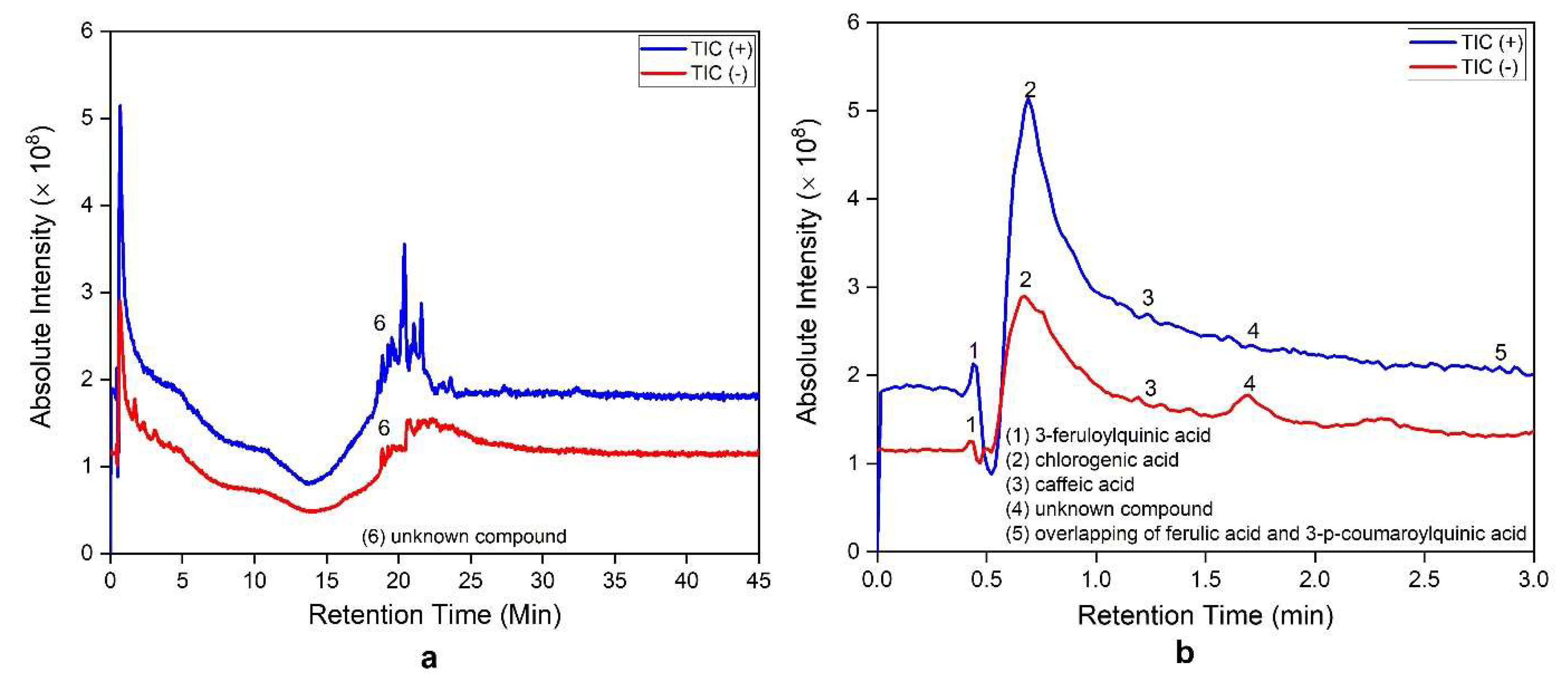
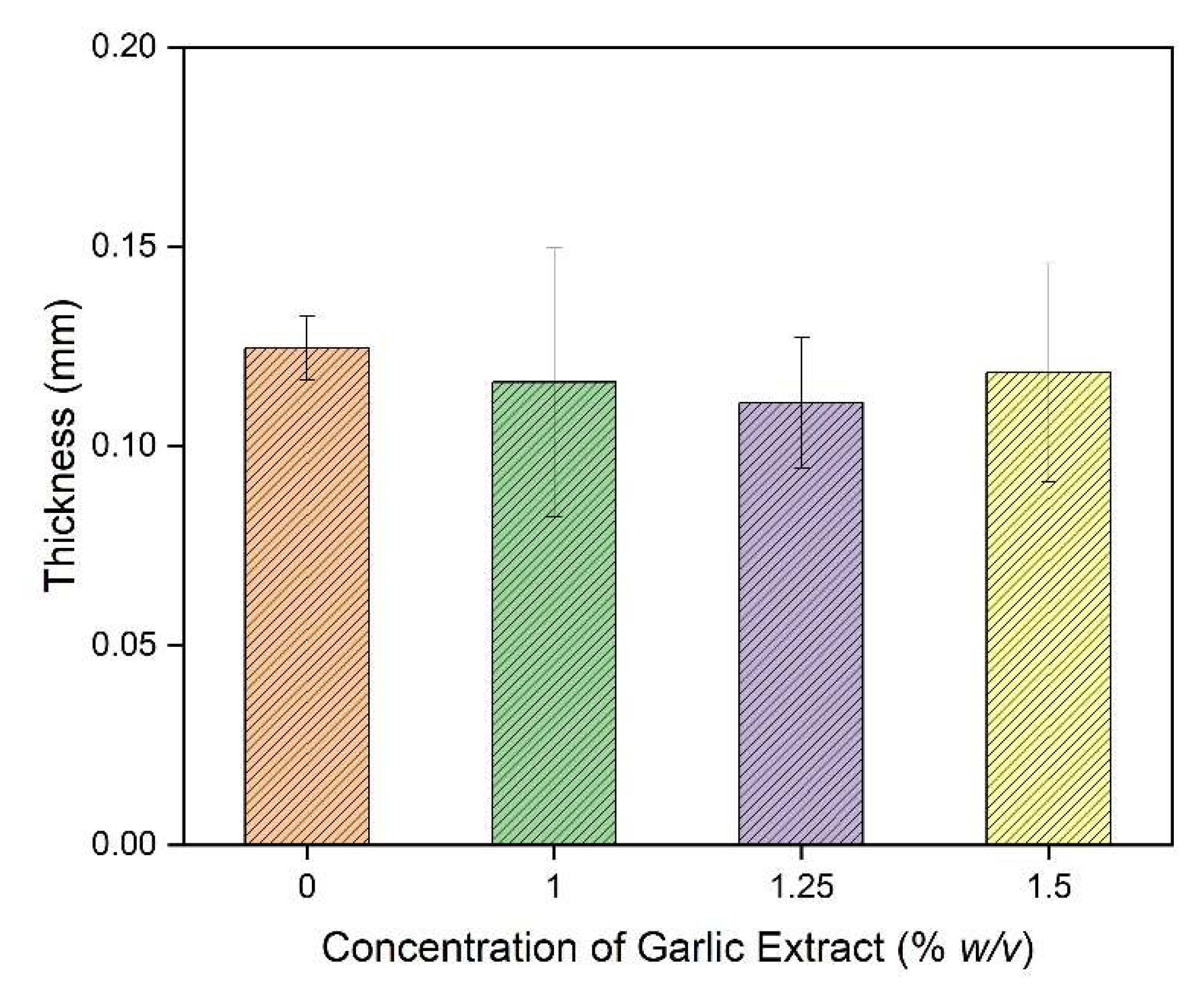
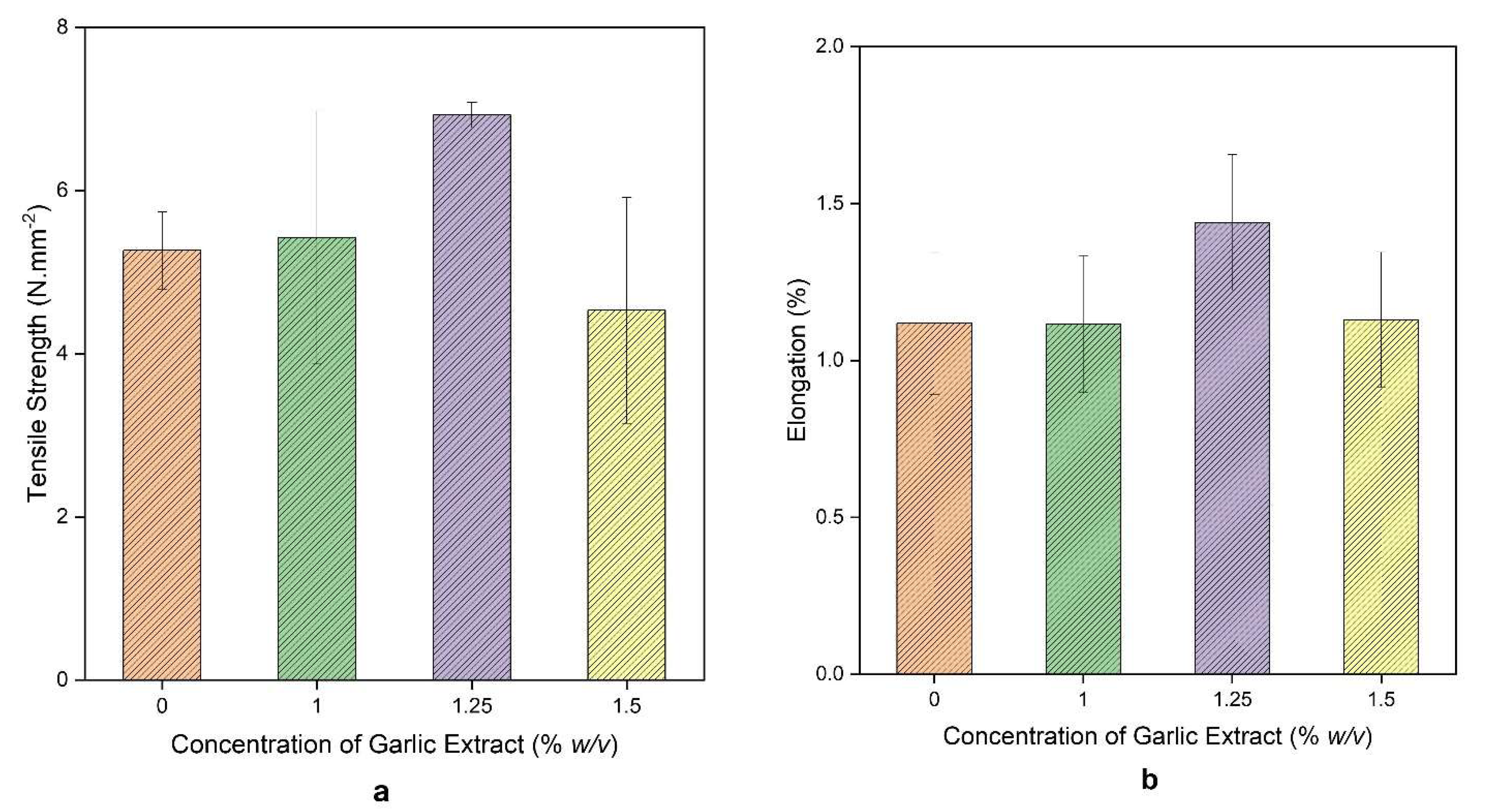
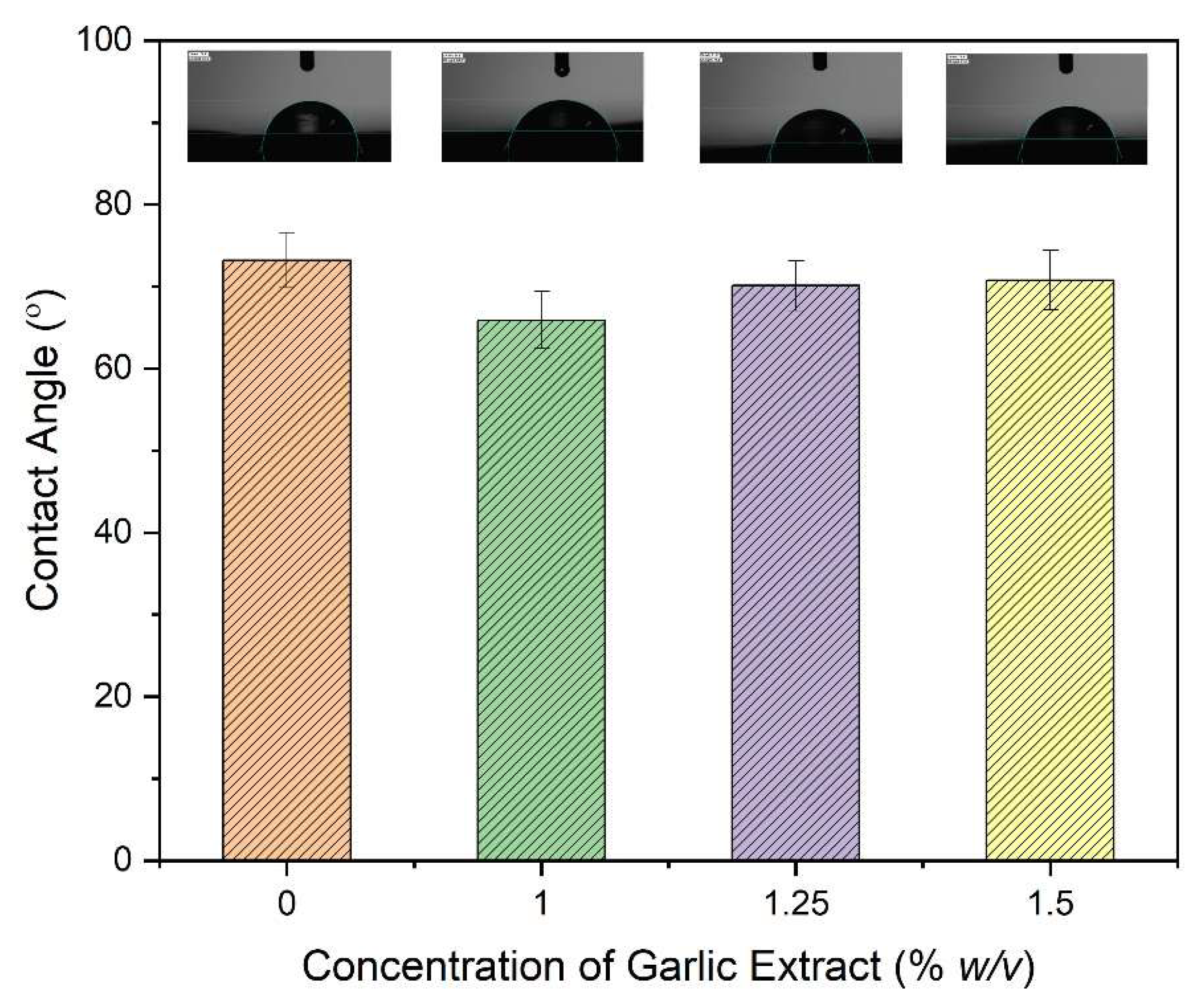
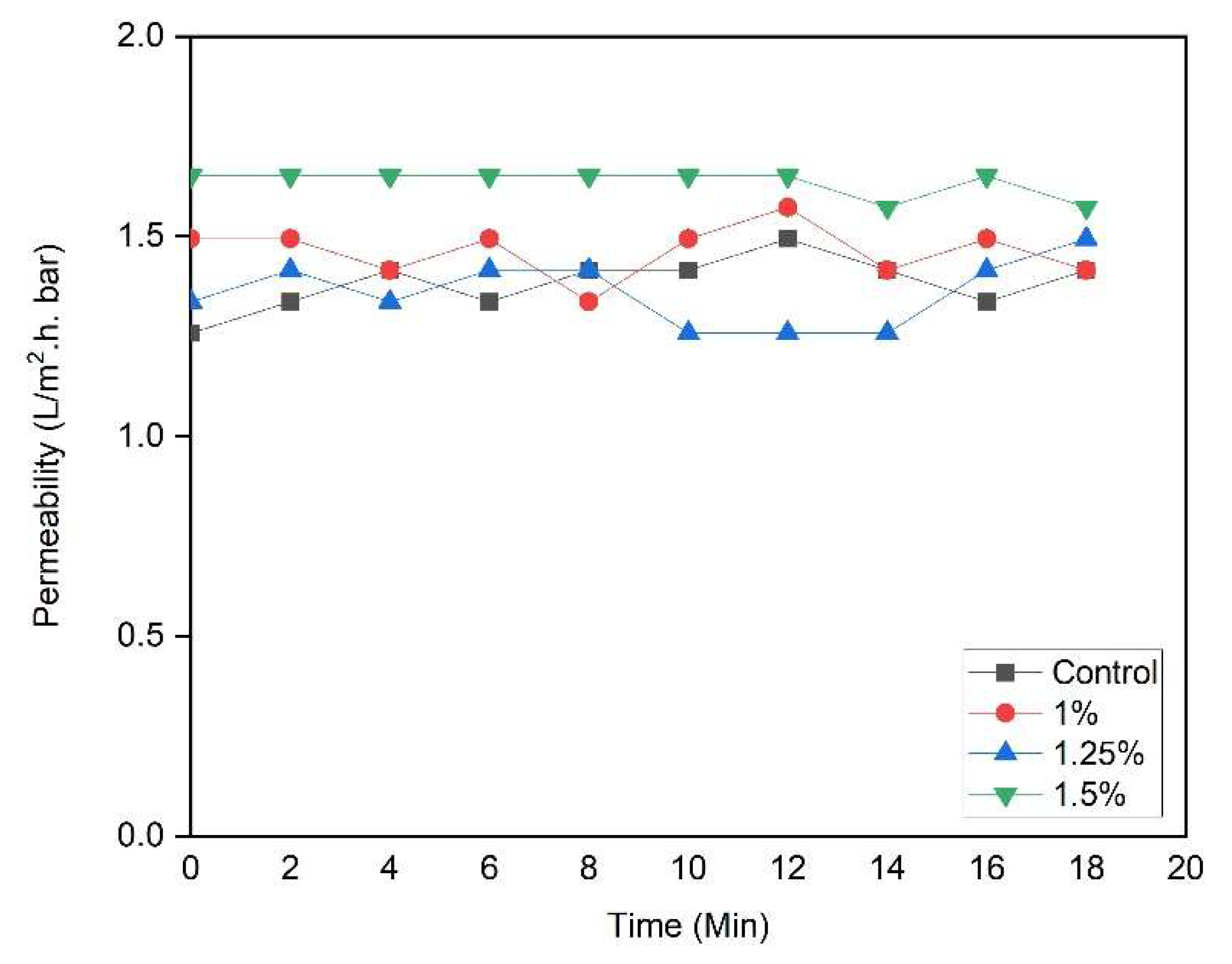
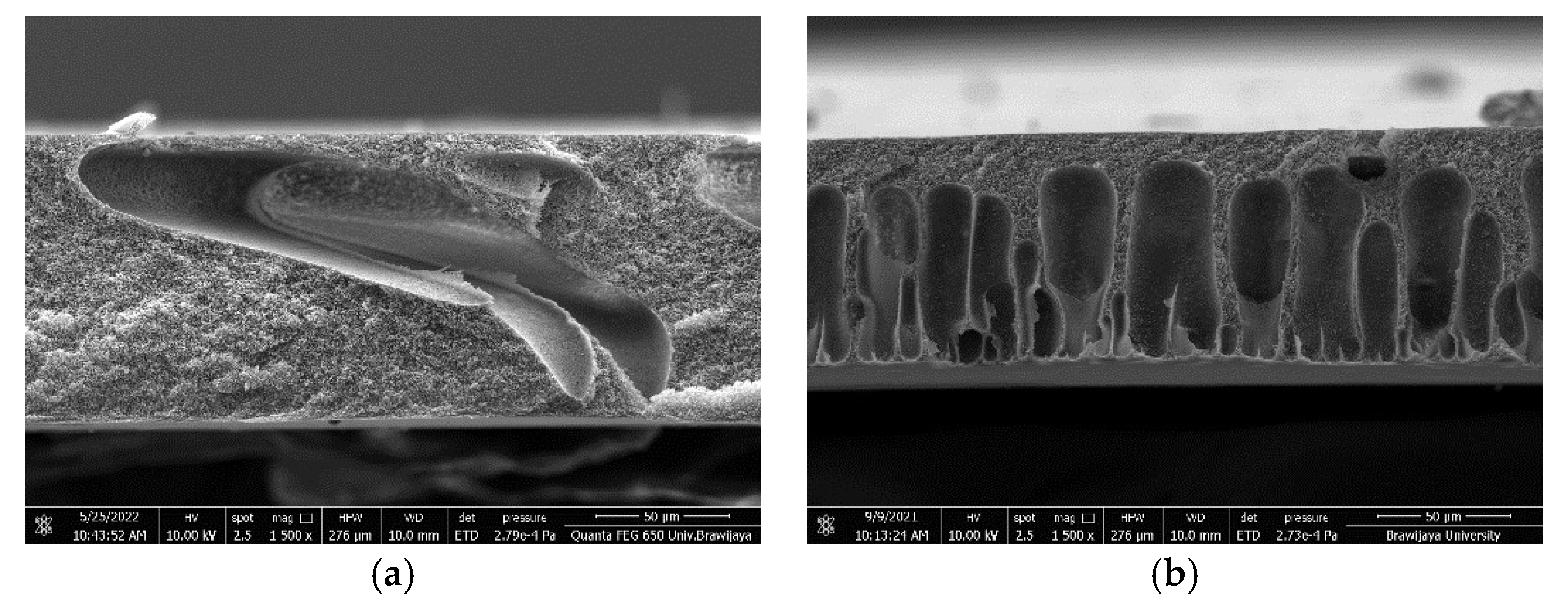
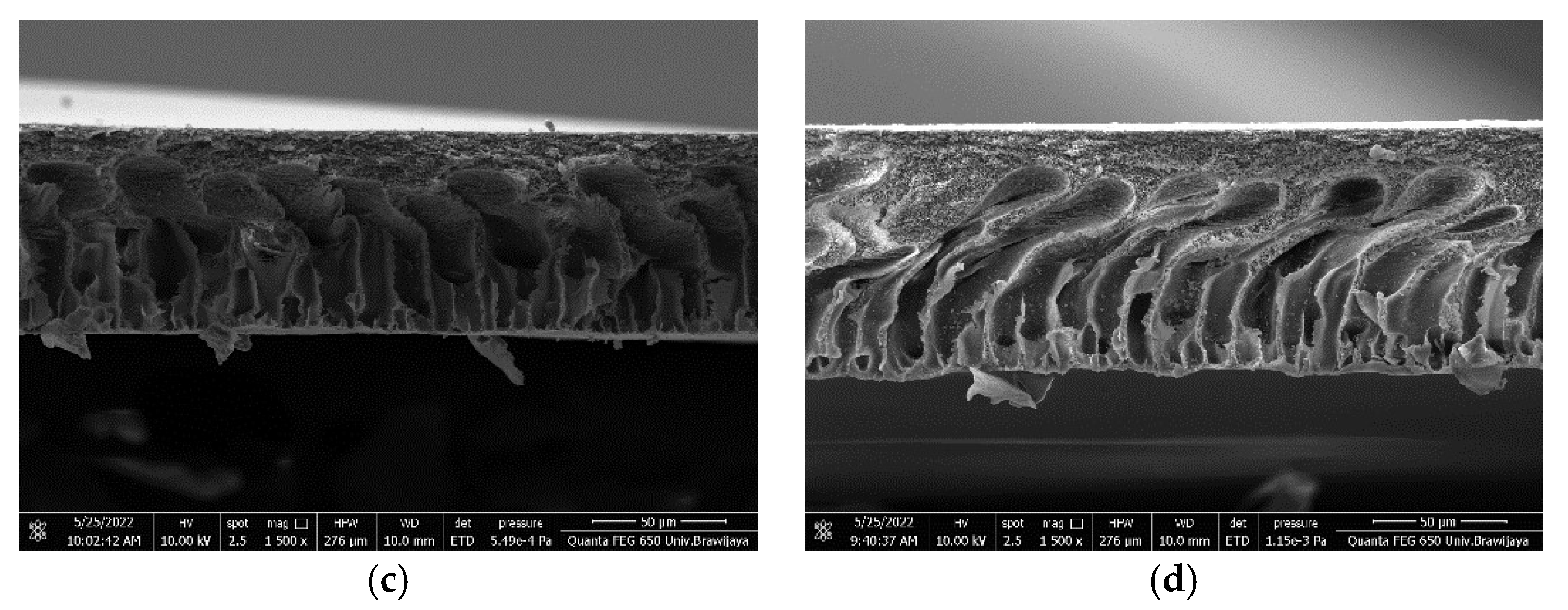

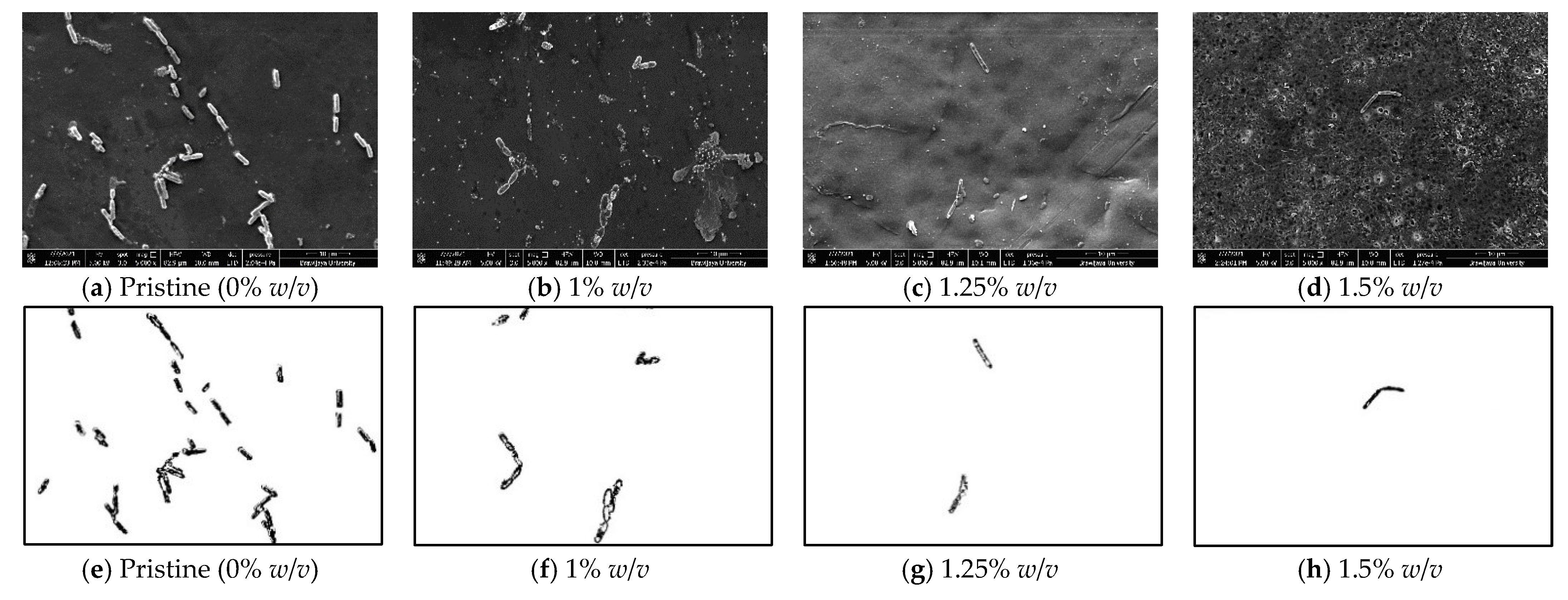
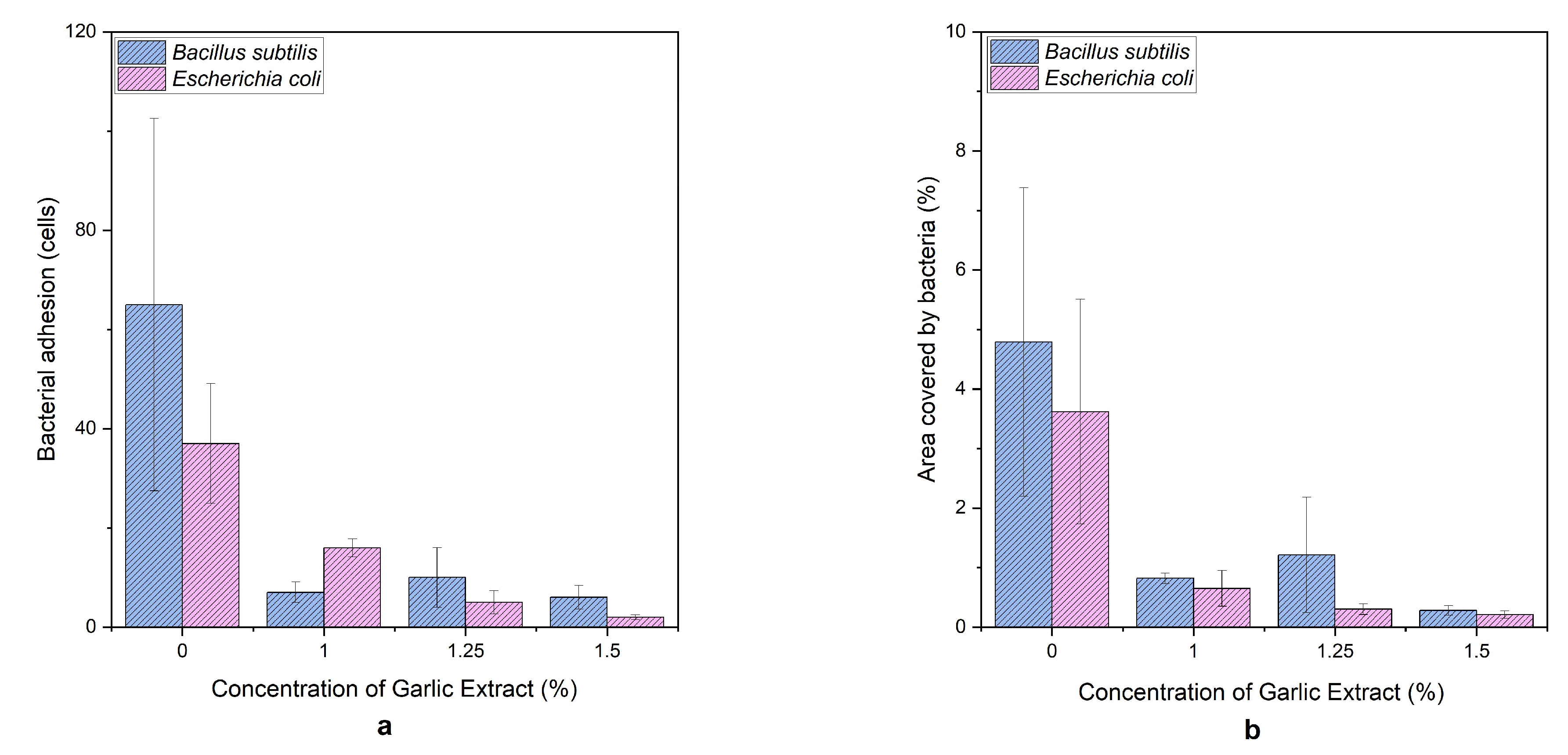
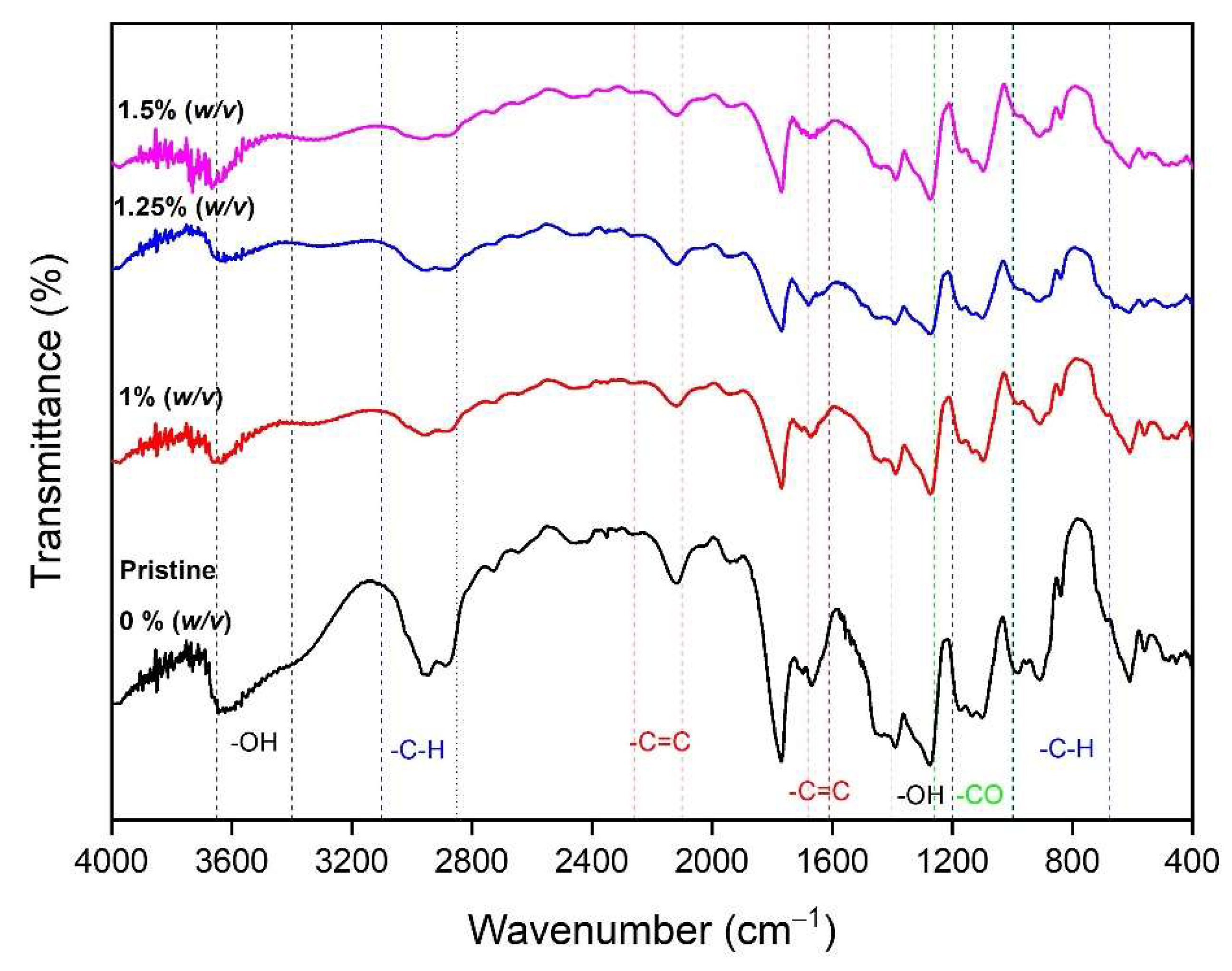
| Antifoulant Types | Compounds | Methods of Incorporation | References |
|---|---|---|---|
| Metallic | Silver | coating, grafting, filling | [10,11,12,13] |
| Copper | coating, grafting, filling | [14,15,16,17] | |
| Gold | coating | [18] | |
| Iron | filling | [19] | |
| Bismuth | chelation, filling | [20,21] | |
| Cobalt | filling | [22] | |
| Nickel | filling | [23] | |
| Inorganic | TiO2 | coating, filling | [24,25,26] |
| ZnO | filling | [27,28,29] | |
| MgO | filling | [30] | |
| RuO2 | filling | [31] | |
| MXene | coating | [32,33,34] | |
| Carbons | Carbon nanotubes | filling | [35,36,37] |
| Graphene oxide | filling | [38,39,40] | |
| Carbon quantum dots | grafting, filling | [41,42,43] | |
| Organics | Chitosan | coating, filling | [44,45,46] |
| 2-Aminoimidazole | filling, blending | [47,48] | |
| Natural | Phenolic | filling | this study |
| Membrane Composition | ||||
|---|---|---|---|---|
| Garlic Extract (g) | Garlic Extract (% w/v) | DMF (mL) | Cellulose Acetate (g) | Initial Thickness (mm) |
| 0 | 0 | 20 | 4.00 | 0.3 |
| 0.04 | 1 | 20 | 3.96 | 0.3 |
| 0.05 | 1.25 | 20 | 3.95 | 0.3 |
| 0.06 | 1.5 | 20 | 3.94 | 0.3 |
| Peak a | Tentative Proposed Compounds | RT (min) | Mode (+/−) | MS b (m/z) | MS/MS (m/z) | References |
|---|---|---|---|---|---|---|
| 1 | 3-Feruloylquinic acid | 0.444 | − | 368 | 338 | [79,80,81] |
| 2 | Chlorogenic acid | 0.678 | − | 354 | 191 | [74,82,83] |
| 3 | Caffeic acid | 1.235 | − | 180 | 89, 134, 145, 163, 180 | [74,78,79,80,82,83] |
| 4 | Unknown | 1.702 | + | 589 | 265, 297, 587 | − |
| 5 | p-coumaric acid | 2.844 | − | 164 | 91, 199, 147 | [80,81,83,84] |
| Ferulic acid | − | 194 | 134, 149 | [74,78,80,81,83,84] | ||
| 3-p-Coumaroylquinic acid | − | 338 | 163, 173 | [74,78] | ||
| 6 | Unknown | 18.897 | + | 465 | 329, 330, 397 | − |
| Membrane-Embedded Garlic Extract (% w/v) | Phenolic Substances (%) |
|---|---|
| 1 | 0.94 |
| 1.25 | 0.81 |
| 1.5 | 0.58 |
Disclaimer/Publisher’s Note: The statements, opinions and data contained in all publications are solely those of the individual author(s) and contributor(s) and not of MDPI and/or the editor(s). MDPI and/or the editor(s) disclaim responsibility for any injury to people or property resulting from any ideas, methods, instructions or products referred to in the content. |
© 2023 by the authors. Licensee MDPI, Basel, Switzerland. This article is an open access article distributed under the terms and conditions of the Creative Commons Attribution (CC BY) license (https://creativecommons.org/licenses/by/4.0/).
Share and Cite
Wibisono, Y.; Alvianto, D.; Argo, B.D.; Hermanto, M.B.; Witoyo, J.E.; Bilad, M.R. Low-Fouling Plate-and-Frame Ultrafiltration for Juice Clarification: Part 1—Membrane Preparation and Characterization. Sustainability 2023, 15, 806. https://doi.org/10.3390/su15010806
Wibisono Y, Alvianto D, Argo BD, Hermanto MB, Witoyo JE, Bilad MR. Low-Fouling Plate-and-Frame Ultrafiltration for Juice Clarification: Part 1—Membrane Preparation and Characterization. Sustainability. 2023; 15(1):806. https://doi.org/10.3390/su15010806
Chicago/Turabian StyleWibisono, Yusuf, Dikianur Alvianto, Bambang Dwi Argo, Mochamad Bagus Hermanto, Jatmiko Eko Witoyo, and Muhammad Roil Bilad. 2023. "Low-Fouling Plate-and-Frame Ultrafiltration for Juice Clarification: Part 1—Membrane Preparation and Characterization" Sustainability 15, no. 1: 806. https://doi.org/10.3390/su15010806
APA StyleWibisono, Y., Alvianto, D., Argo, B. D., Hermanto, M. B., Witoyo, J. E., & Bilad, M. R. (2023). Low-Fouling Plate-and-Frame Ultrafiltration for Juice Clarification: Part 1—Membrane Preparation and Characterization. Sustainability, 15(1), 806. https://doi.org/10.3390/su15010806










